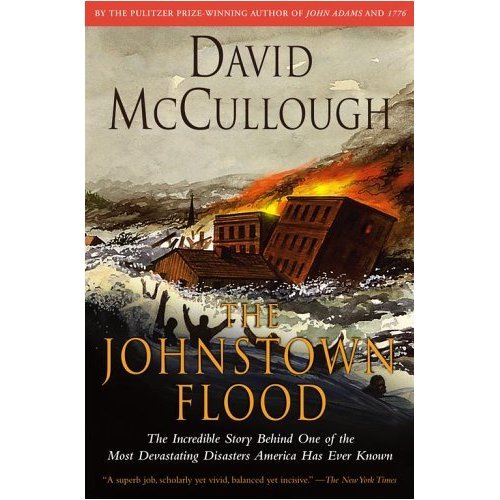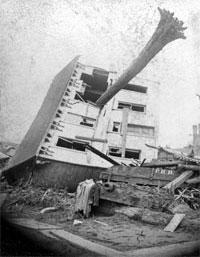 Perhaps no other author can lock me into a book so quickly than David McCullough. His moving biography of John Adams is a favorite of mine, as is the fast paced 1776, both of which I commend to anyone interested in the history of our nation. Of course, all of us know that a book should not be judged by its first few paragraphs, and to this I think McCullough would agree. I can think, however, of many books I’ve picked up recently where reading the first chapter is like walking through heavy mud. McCullough is not of this sort. As a historical novelist, he walks the reader into the story so that he may feel, taste, hear and see the world about which he reads. After trudging through three J-term courses this winter, I decided to read leisurely while waiting for my upcoming, and last, semester. I picked up McCullough’s first book, The Johnstown Flood, and instantly felt like a character in this incredible story.
Perhaps no other author can lock me into a book so quickly than David McCullough. His moving biography of John Adams is a favorite of mine, as is the fast paced 1776, both of which I commend to anyone interested in the history of our nation. Of course, all of us know that a book should not be judged by its first few paragraphs, and to this I think McCullough would agree. I can think, however, of many books I’ve picked up recently where reading the first chapter is like walking through heavy mud. McCullough is not of this sort. As a historical novelist, he walks the reader into the story so that he may feel, taste, hear and see the world about which he reads. After trudging through three J-term courses this winter, I decided to read leisurely while waiting for my upcoming, and last, semester. I picked up McCullough’s first book, The Johnstown Flood, and instantly felt like a character in this incredible story.
Johnstown, Pennsylvania, located southeast of Pittsburgh, was a small but thriving factory town of about 30,000 citizens in 1889. The people were diverse, hardworking and content, typical of late 19th century American industrialism. Their town, however, sat at the fork of two rivers (the Stony Creek and Little Conemaugh) that overflow their banks every other spring when heavy rains drench the area. But since no one ever died there was never any attempt to control the waters up to that point, and the floods became commonplace. About 10-15 miles up the Little Conemaugh river was a resort for the Pittsburgh wealthy, which included a large lake upheld by a small, old dam built of stone. The dam contained a spillway which fed into the Little Conemaugh. Johnstown’s residents knew that if the dam were ever to break the flood waters would likely wipe out their town, yet they did nothing to secure the dam or assure that high water on the lake would not spill over. Numerous engineers and others suggested the dam be rebuilt or somehow stabilized, yet the Johnstown public repeatedly balked at the idea. After all, money was tight and resources costly. When the flood waters came year after year the dam continued to hold, which bolstered the confidence of Johnstown. But no one expected the the events of May 31st, for that flood wasn’t like any other. 
On May 30th a torrential downpour caused the lake at the dam to rise as much as one inch every ten minutes. Through the night the water at the crest of the dam rose from six feet to only two feet. The caretakers of the resort and dam knew that if the rain kept pouring Johnstown could be in for a natural disaster, so they wired to Johnstown hour after hour in an attempt to alert the citizens of a possible break at the dam. By morning of the 31st Johnstown was already partially flooded, about knee-high, which was a typical spring soaking. For them there was no reason to fear, so they went about their day as usual. After hearing the alerts about the dam, most chuckled at the prospect of a break. This concerned the caretakers of the resort, and a few even came down on horseback to alert the citizens themselves. However, only some in Johnstown fled to the hills, and most didn’t take notice. Most striking was the lack of attention given to the dam by Johnstown’s politicians, who likewise neglected to leave their own comfortable homes, let alone inform the public about an impending disaster. Yet about 2:50 P.M. the dam finally gave way and the waters rushed on, picking up trees, houses, debris, mud, rock and barbwire as it headed to Johnstown traveling 15 miles/hour. It was not a wave like those that crash into the Florida coast. Rather, it was a was a giant hill, 30-40 feet high of blackness, “a blur, an advance guard, as it were as mist, like dust that precedes a cavalry charge.” One onlooker described the wave as “a cloud of blackest smoke I ever saw.” Most impressionable was the terrible sound of the thing, and the ambivalence of those in Johnstown who neglected to leave the city. McCullough writes, “most of the people in Johnstown never saw the water coming; they only heard it; and those who lived to tell about it would for years after try to describe the sound of the thing as it rushed on them.”
The flood came upon Johnstown with great force, and McCullough describes the catastrophic event with precision and detail. In the end, 2,209 people lost their lives, many whose bodies were never found. Although thousands came to help the recovery and rescue effort, the clean-up would take months, even years. Many tried to sue the resort and caretakers of the dam for the loss of life, but the blame, writes McCullough, should be shifted. Indeed, the overarching theme of the book concerns the complacency of Johnstown’s own residents and leaders. In this light it is important to notice that the Johnstown flood is not simply a story about a natural disaster. It is a different subject than, say, the stories of the Chicago fire or the great San Francisco earthquake. It is more like hurricane Katrina. The theme of the Johnstown flood is that it is extremely risky, perhaps even perilous, to assume that because people are in positions of responsibility they are acting responsibly. The Johnstown flood, then, is a story of human irresponsibility, of shortsightedness of the clear “writing on the wall,” as it were. It is about man at his most thoughtless and naive.
Aside from the obvious downside of the flood itself, I loved this book. McCullough is a historical writer par excellence, and I highly recommended his works to anyone, young or old, for a satisfying and informing read.
